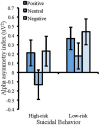The Association Between Suicidal Behavior, Attentional Control, and Frontal Asymmetry
- PMID: 29593586
- PMCID: PMC5861137
- DOI: 10.3389/fpsyt.2018.00079
The Association Between Suicidal Behavior, Attentional Control, and Frontal Asymmetry
Abstract
It can be difficult to identify those at risk of suicide because suicidal thoughts are often internalized and not shared with others. Yet to prevent suicide attempts it is crucial to identify suicidal thoughts and actions at an early stage. Past studies have suggested that deficits in attentional control are associated with suicide, with the argument that individuals are unable to inhibit negative thoughts and direct resources away from negative information. The current study aimed to investigate the association of suicidal behavior with neurological and behavioral markers, measuring attentional bias and inhibition in two Stroop tasks. Fifty-four participants responded to the color of color words in a standard Stroop task and the color of positive, negative, and neutral words in an emotional Stroop task. Electroencephalographic (EEG) activity was recorded from frontal areas during each task and at resting. Participants were separated into a low-risk and high-risk group according to their self-reported suicidal behavior. Participants in the high-risk group showed slower response times in the color Stroop and reduced accuracy to incongruent trials, but faster response times in the emotional Stroop task. Response times to the word "suicide" were significantly slower for the high-risk group. This indicates an attentional bias toward specific negative stimuli and difficulties inhibiting information for those with high levels of suicidal behavior. In the emotional Stroop task the high-risk group showed reduced activity in leftward frontal areas, suggesting limitations in the ability to regulate emotional processing via the left frontal regions. The findings support the argument that deficits in attentional control are related to suicidal behavior. The research also suggests that under certain conditions frontal asymmetry may be associated with suicidal behavior.
Keywords: attentional control; capability model; emotional Stroop; frontal asymmetry; inhibition; suicide.
Figures



Similar articles
-
Abnormal attentional bias in individuals with suicidal ideation during an emotional Stroop task: an event-related potential study.Front Psychiatry. 2023 Aug 22;14:1118602. doi: 10.3389/fpsyt.2023.1118602. eCollection 2023. Front Psychiatry. 2023. PMID: 37674549 Free PMC article.
-
Attentional Bias Deficits in Adolescent Suicide Attempters During an Emotional Stroop Task: An ERP Study.Front Psychiatry. 2021 Oct 1;12:694147. doi: 10.3389/fpsyt.2021.694147. eCollection 2021. Front Psychiatry. 2021. PMID: 34658946 Free PMC article.
-
Differences in suicide-specific attentional bias based on stimuli across the suicide Stroop and disengagement tasks.J Affect Disord. 2025 Jan 15;369:87-94. doi: 10.1016/j.jad.2024.09.136. Epub 2024 Sep 24. J Affect Disord. 2025. PMID: 39326588
-
Chronic Pain and Emotional Stroop: A Systematic Review.J Clin Med. 2022 Jun 7;11(12):3259. doi: 10.3390/jcm11123259. J Clin Med. 2022. PMID: 35743329 Free PMC article. Review.
-
Generalizability of carry-over effects in the emotional Stroop task.Behav Res Ther. 2005 Jun;43(6):715-32. doi: 10.1016/j.brat.2004.06.003. Behav Res Ther. 2005. PMID: 15890165 Review.
Cited by
-
Implicit Cognition Tests for the Assessment of Suicide Risk: a Systematic Review.Curr Psychiatry Rep. 2022 Feb;24(2):141-159. doi: 10.1007/s11920-022-01316-5. Epub 2022 Feb 12. Curr Psychiatry Rep. 2022. PMID: 35150387 Free PMC article.
-
Adaptation of an Emotional Stroop Test for Screening of Suicidal Ideation in Portugal.Behav Sci (Basel). 2022 Aug 12;12(8):281. doi: 10.3390/bs12080281. Behav Sci (Basel). 2022. PMID: 36004852 Free PMC article.
-
A resting state EEG study on depressed persons with suicidal ideation.IBRO Neurosci Rep. 2023 Mar 24;14:346-352. doi: 10.1016/j.ibneur.2023.03.012. eCollection 2023 Jun. IBRO Neurosci Rep. 2023. PMID: 37063608 Free PMC article.
-
Neuroimaging insights into recent suicide attempters utilizing the raven task.PLoS One. 2025 Aug 4;20(8):e0327562. doi: 10.1371/journal.pone.0327562. eCollection 2025. PLoS One. 2025. PMID: 40758670 Free PMC article.
-
The Psychological Pathway to Suicide Attempts: A Strategy of Control Without Awareness.Front Psychol. 2021 Mar 18;12:588683. doi: 10.3389/fpsyg.2021.588683. eCollection 2021. Front Psychol. 2021. PMID: 33815194 Free PMC article.
References
LinkOut - more resources
Full Text Sources
Other Literature Sources
Medical
Miscellaneous

